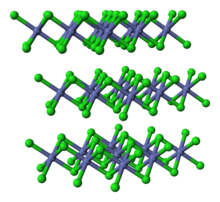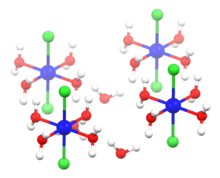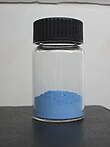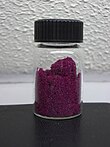
Back كلوريد الكوبالت الثنائي Arabic کولورید کوبالت (II) AZB Clorur de cobalt(II) Catalan Chlorid kobaltnatý Czech Cobalt(II)-chlorid German Διχλωριούχο κοβάλτιο Greek Kobalta (II) klorido Esperanto Cloruro de cobalto(II) Spanish کبالت(II) کلرید Persian Kobolttikloridi Finnish
| |||
 Structure of anhydrous compound
| |||
 Structure of hexahydrate
| |||
| Names | |||
|---|---|---|---|
| IUPAC name
Cobalt(II) chloride
| |||
| Other names | |||
| Identifiers | |||
| |||
3D model (JSmol)
|
|||
| ChEBI | |||
| ChemSpider | |||
| ECHA InfoCard | 100.028.718 | ||
| EC Number |
| ||
PubChem CID
|
|||
| RTECS number |
| ||
| UNII |
| ||
| UN number | 3288 | ||
CompTox Dashboard (EPA)
|
|||
| |||
| |||
| Properties | |||
| CoCl2 | |||
| Molar mass | 129.839 g/mol (anhydrous) 165.87 g/mol (dihydrate) 237.93 g/mol (hexahydrate) | ||
| Appearance | blue crystals (anhydrous) violet-blue (dihydrate) rose red crystals (hexahydrate) | ||
| Density | 3.356 g/cm3 (anhydrous) 2.477 g/cm3 (dihydrate) 1.924 g/cm3 (hexahydrate) | ||
| Melting point | 726 °C (1,339 °F; 999 K) ±2 (anhydrous)[2] 140 °C (monohydrate) 100 °C (dihydrate) 86 °C (hexahydrate) | ||
| Boiling point | 1,049 °C (1,920 °F; 1,322 K) | ||
| 43.6 g/100 mL (0 °C) 45 g/100 mL (7 °C) 52.9 g/100 mL (20 °C) 105 g/100 mL (96 °C) | |||
| Solubility | 38.5 g/100 mL (methanol) 8.6 g/100 mL (acetone) soluble in ethanol, pyridine, glycerol | ||
| +12,660·10−6 cm3/mol | |||
| Structure | |||
| CdCl2 structure | |||
| hexagonal (anhydrous) monoclinic (dihydrate) Octahedral (hexahydrate) | |||
| Hazards | |||
| GHS labelling: | |||
  
| |||
| NFPA 704 (fire diamond) | |||
| Flash point | Non-flammable | ||
| Lethal dose or concentration (LD, LC): | |||
LD50 (median dose)
|
80 mg/kg (rat, oral) | ||
| Safety data sheet (SDS) | ICSC 0783 | ||
| Related compounds | |||
Other anions
|
Cobalt(II) fluoride Cobalt(II) bromide Cobalt(II) iodide | ||
Other cations
|
Rhodium(III) chloride Iridium(III) chloride | ||
Except where otherwise noted, data are given for materials in their standard state (at 25 °C [77 °F], 100 kPa).
| |||
Cobalt(II) chloride is an inorganic compound, a salt of cobalt and chlorine, with the formula CoCl
2. The compound forms several hydrates CoCl
2·nH
2O, for n = 1, 2, 6, and 9. Claims of the formation of tri- and tetrahydrates have not been confirmed.[4] The anhydrous form is a blue crystalline solid; the dihydrate is purple and the hexahydrate is pink. Commercial samples are usually the hexahydrate, which is one of the most commonly used cobalt salts in the lab.[5]
- ^ "Cobalt muriate, CAS Number: 7646-79-9". www.chemindustry.com. Archived from the original on 28 May 2019. Retrieved 19 April 2018.
- ^ Cite error: The named reference
wojakwas invoked but never defined (see the help page). - ^ Santa Cruz Biotechnology: Cobalt(II) chloride
- ^ M. T. Saugier, M. Noailly, R. Cohen-Adad, F. Paulik, and J. Paulik (1977): "Equilibres solide ⇄ liquide ⇆ vapeur du systeme binaire CoCl
2-H
2O" Journal of Thermal Analysis, volume 11, issue 1, pages 87–100. doi:10.1007/BF02104087 Note: the lowest point of fig.6 is inconsistent with fig.7; probably should be at -27.8 C instead of 0 C. - ^ Greenwood, Norman N.; Earnshaw, Alan (1997). Chemistry of the Elements (2nd ed.). Butterworth-Heinemann. ISBN 978-0-08-037941-8.


